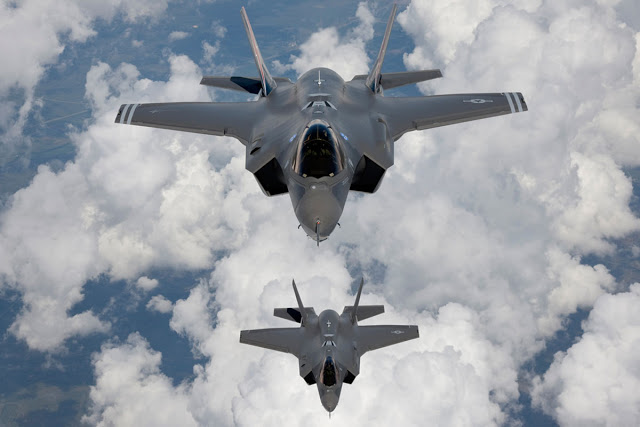Air Force Secretary Deborah Lee James has admitted to a wide range of past and present problems with the F-35 while maintaining that the fifth-general will eventually guarantee the U.S. continued air supremacy over rivals.
* Report says F35 is visible to enemy sensors which is a big problem for a stealth fighter
* This visible problem is combined with admitted fighting problems
* Software and cost problems remain unresolved
* US Navy likely to reduce its order of F35s to 12 per year
A Washington think tank released a report Tuesday that found the 5th-generation jet – billed as the world’s most advanced fighter – will be outmaneuvered in dogfights with current Russian and Chinese jets as well as the U.S. aircraft it is slated to replace. The report comes after details were leaked last month on a test flight where the F-35 was bested in most aerial maneuvering by an F-16.
“The F-35 will find itself outmaneuvered, outgunned, out of range, and visible to enemy sensors,” according to Bill French, a policy analyst with the National Security Network, a progressive think tank that claims to challenge overly militarized conservative defense policies. “Staying the present course [on the aircraft program] may needlessly gamble away a sizable margin of American airpower at great expense and unnecessary risk to American lives.”
Navy likely to cut order from 20 F35s per year to 12
The US Navy believes budget pressures and competing priorities could drive it to purchase fewer Lockheed Martin F-35Cs per year in the 2020s, and a worst-case scenario could see it procure as few as 12 aircraft per year, or one squadron.
Naval Air Forces commander Vice Adm Mike Shoemaker says the current plan is to purchase around 20 carrier variants per year in the 2020s, but depending on the resources available, annual output could fall to anywhere between 12 and 20 aircraft.
“I think the current realities of the budget and other priories inside the navy may drive something between those two numbers, but we’re still on the path to [initial operational capability] for our first squadron in 2018,” Shoemaker said at the US Centre for Strategic and International Studies in Washington.
The navy is by far the least enthusiastic recipient of the F-35, with the Marine Corps and Air Force holding firm on their annual buys despite facing similar budget pressures. The C-model was designed specifically for carrier-based operations and has larger wings and horizontal tails as well as stronger landing gear than the A- and B-models.
The navy paying $265 million per F-35C in fiscal year 2014, but also because the navy has a more modern combat fleet comprised mostly of newer F/A-18 Super Hornets. Even though the cost per jet is expected to fall to $144 million in 2020, it far exceeds the $80 million to $90 million the navy was paying for Boeing Super Hornets over the past few years.Lockheed Martin aims to bring the average cost of an F-35A down to $80 million by 2019, but much of the anticipated savings come from increased quantities. The company expects to ramp up Joint Strike Fighter production to more than 160 aircraft in 2019, and is also eyeing a multi-year block buy for about 450 jets that combines domestic and international orders.
Next time we have hundreds of billions for next generation planes then do not fly while building
“The biggest lesson I have learned from the F-35 is never again should we be flying an aircraft while we’re building it,” James said at the Aspen Security Forum in Colorado last week.
In development stages, “People believed we could go faster, cheaper, better” by designing and building the F-35 concurrently, “and that the degree of concurrency would work. Indeed it has not worked as well as we had hoped and that’s probably the understatement of the day,” James said.
“It has taken us too long, it has cost us way more money than we ever imagined possible,” James said of the most expensive weapons program in Pentagon history. “We’re very focused from now on to driving the cost down per unit and they are coming down.”
However, she noted that there were additional challenges to making the Lockheed Martin F-35 Lightning II operational. “I would sum it up in one word – software,” James said, noting the 24 million lines of code in the aircraft.
F-16 Dogfight admission from Air Force
James also agreed that an F-35A “didn’t do so well” in mock dogfights with an F-16 last January. The test pilot’s assessment, first reported by the “War Is Boring” blog, said that the F-35 lacked the maneuverability to keep up with the F-16 and the F-35 pilot’s helmet cut down on his vision.
“There were multiple occasions when the bandit (F-16) would’ve been visible but the helmet prevented getting in a position to see him,” the report said.
James said the dogfight against the F-16 provided the F-35 program with valuable data but she also stressed that the F-35 will be a different plane when it’s fully operational.
SOURCE – Stars and Stripes, military.com by Travis J. Tritten and Richard Sisk, Flight Global

Brian Wang is a Futurist Thought Leader and a popular Science blogger with 1 million readers per month. His blog Nextbigfuture.com is ranked #1 Science News Blog. It covers many disruptive technology and trends including Space, Robotics, Artificial Intelligence, Medicine, Anti-aging Biotechnology, and Nanotechnology.
Known for identifying cutting edge technologies, he is currently a Co-Founder of a startup and fundraiser for high potential early-stage companies. He is the Head of Research for Allocations for deep technology investments and an Angel Investor at Space Angels.
A frequent speaker at corporations, he has been a TEDx speaker, a Singularity University speaker and guest at numerous interviews for radio and podcasts. He is open to public speaking and advising engagements.


